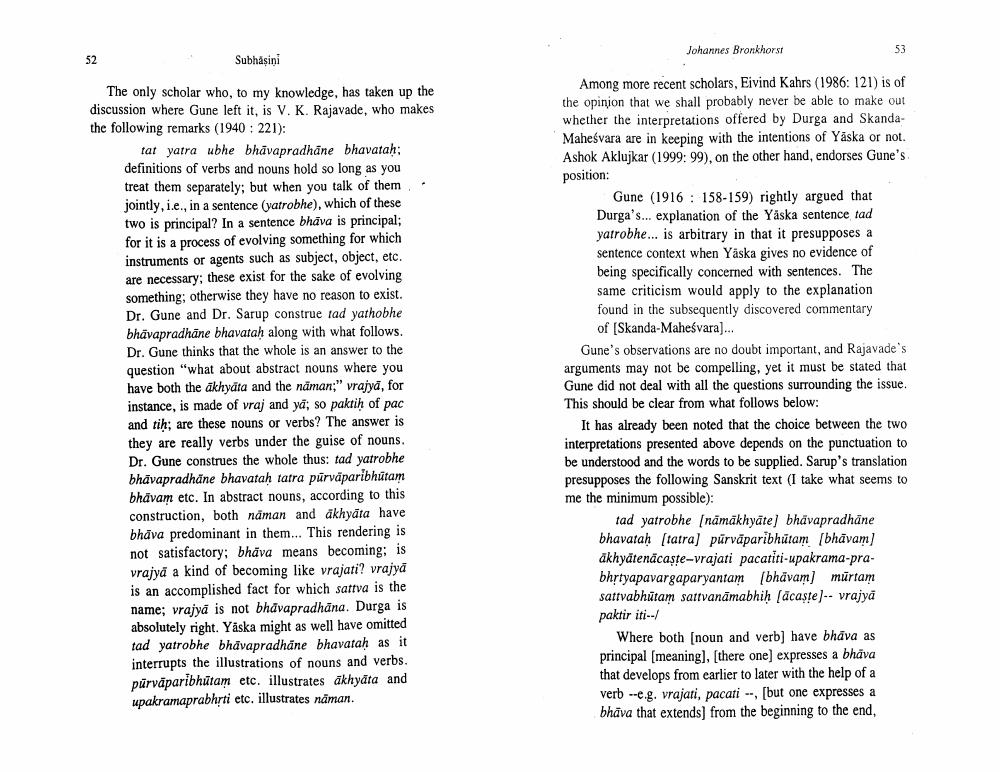Book Title: Yaska And Sentence Beginning Ofsabdabodha Author(s): Johannes Bronkhorst Publisher: Johannes Bronkhorst View full book textPage 5
________________ Johannes Bronkhorst Subhaşini The only scholar who, to my knowledge, has taken up the discussion where Gune left it, is V. K. Rajavade, who makes the following remarks (1940: 221): tat yatra ubhe bhāvapradhane bhavatah; definitions of verbs and nouns hold so long as you treat them separately; but when you talk of them jointly, i.e., in a sentence (yatrobhe), which of these two is principal? In a sentence bhāva is principal; for it is a process of evolving something for which instruments or agents such as subject, object, etc. are necessary; these exist for the sake of evolving something; otherwise they have no reason to exist. Dr. Gune and Dr. Sarup construe tad yathobhe bhävapradhane bhavatah along with what follows. Dr. Gune thinks that the whole is an answer to the question "what about abstract nouns where you have both the ākhyāta and the naman;" vrajyā, for instance, is made of vraj and yā; so paktih of pac and tih; are these nouns or verbs? The answer is they are really verbs under the guise of nouns. Dr. Gune construes the whole thus: tad yatrobhe bhävapradhäne bhavatah tatra purväparibhutam bhavam etc. In abstract nouns, according to this construction, both naman and akhyata have bhava predominant in them... This rendering is not satisfactory; bhāva means becoming; is vrajya a kind of becoming like vrajati? vrajyā is an accomplished fact for which sattva is the name; vrajya is not bhāvapradhāna. Durga is absolutely right. Yaska might as well have omitted tad yatrobhe bhāvapradhane bhavataḥ as it interrupts the illustrations of nouns and verbs. pūrväparibhūtam etc. illustrates akhyata and upakramaprabhrti etc. illustrates näman. Among more recent scholars, Eivind Kahrs (1986: 121) is of the opinion that we shall probably never be able to make out whether the interpretations offered by Durga and SkandaMaheśvara are in keeping with the intentions of Yaska or not. Ashok Aklujkar (1999: 99), on the other hand, endorses Gune's position: Gune (1916 : 158-159) rightly argued that Durga's... explanation of the Yaska sentence tad yatrobhe... is arbitrary in that it presupposes a sentence context when Yaska gives no evidence of being specifically concerned with sentences. The same criticism would apply to the explanation found in the subsequently discovered commentary of (Skanda-Maheśvara).... Gune's observations are no doubt important, and Rajavade's arguments may not be compelling, yet it must be stated that Gune did not deal with all the questions surrounding the issue. This should be clear from what follows below: It has already been noted that the choice between the two interpretations presented above depends on the punctuation to be understood and the words to be supplied. Sarup's translation presupposes the following Sanskrit text (I take what seems to me the minimum possible): tad yatrobhe (nāmākhyāte) bhävapradhäne bhavatah (tatra) purvāparibhūtam (bhāvam) akhyatenācaste-vrajati pacatiti-upakrama-prabhrtyapavargaparyantam (bhāvam] mūrtam sattvabhūtam sattvanāmabhih (ācaste)-- vrajyā paktir iti--/ Where both (noun and verb) have bhāva as principal (meaning), (there one) expresses a bhava that develops from earlier to later with the help of a verb --e.g. vrajati, pacati --, [but one expresses a bhāva that extends) from the beginning to the end,Page Navigation
1 ... 3 4 5 6 7 8 9 10
